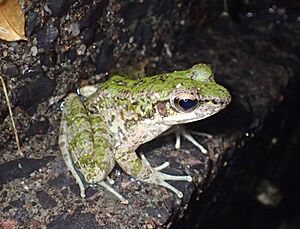Amami tip-nosed frog facts for kids
Quick facts for kids Amami tip-nosed frog |
|
|---|---|
 |
|
| Conservation status | |
| Scientific classification | |
| Synonyms | |
|
Rana amamiensis Matsui, 1994 |
The Amami tip-nosed frog (Odorrana amamiensis) is a special kind of frog. It belongs to the family called Ranidae. This frog is found only in the Amami Islands in Japan. These islands are part of the Ryukyu Islands. You can find this unique frog on the islands of Amamioshima and Tokunoshima. It is an endemic species, meaning it lives nowhere else in the world.
Contents
What Does the Amami Tip-Nosed Frog Look Like?
Adult male Amami tip-nosed frogs are about 5.7 to 6.9 centimeters (2.2 to 2.7 inches) long. Female frogs are larger, measuring about 7.6 to 10.1 centimeters (3 to 4 inches). Their bodies are quite slim. They have a triangular head and a pointed snout.
Special Features of Their Body
The frog's eardrum, called the tympanum, is easy to see. Their fingers do not have webbing between them. However, their toes have good webbing, which helps them swim. Both their fingers and toes have small sticky pads, or discs, at the tips.
The skin on their back, called the dorsum, can be light brown or green. It often has scattered bumps, like tiny warts. Many frogs have large black spots and dark dots on their back. Some frogs might not have these spots.
Markings and Colors
There are usually dark marks near their eyes and around their eardrums. Dark stripes can also be seen across their legs. Male frogs have two vocal sacs under their chin. These sacs inflate when they call out.
Where Do Amami Tip-Nosed Frogs Live and How Are They Protected?
The Amami tip-nosed frog lives near streams. These streams are usually found in broad-leaved evergreen forests. They are common in mountain streams. However, you will rarely find them in lower areas.
Breeding Habits
These frogs breed from mid-October to early May. The busiest time for breeding is from late December to early January. Many groups of eggs have been found at the bottom of waterfalls.
Threats to Their Survival
Sadly, the Amami tip-nosed frog faces several dangers. One big threat is habitat loss. This happens when their forest homes are cut down for logging. It also occurs when new roads are built.
Changes to rivers and pollution from farm chemicals also hurt them. Another problem is mongooses. These animals are not native to the islands. They hunt the frogs, which makes it harder for the frogs to survive.


